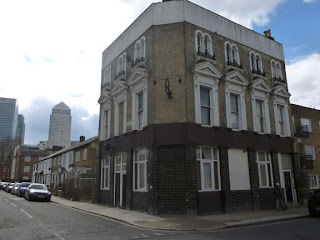The panoramic
picture at the top of this blog is the view from my kitchen and lounge windows.
I’ve spent years gazing out westward
when I should have been concentrating on boring things like work etc. I’ve even
seen the Red Arrows, a Spitfire and a Lancaster bomber fly over before, not to mention the omni-present police helicopters.
Some people like
looking at hills, or valleys, or mountains or the sea. But this London vista of towers on the
skyline, complete with a cluttered foreground of varied London flats, is my
delight.
The cityscape views
I see from my flat includes a glimpse of the Olympic stadium, the O2 Dome, the
Canary Wharf estate (so large and near it’s almost like my garden fence), the
Shard and the City skyscrapers.
I can see the remote-controlled Docklands Light Railway trains travelling over a viaduct and disappearing into the glass and steel bow-arc roof of
Canary Wharf station, nestled underneath the tall grey and silver giants of
the Canary Wharf skyscrapers. Air traffic from nearby City Airport soars
in and out low over my head. Looking out
of my huge south facing living room window I can sometimes make out the funnels
of luxury liners and ships that occasionally dock near Blackwall. On a clear
day I can just make out the dome of the Royal Observatory at Greenwich, and on
the horizon the thick woodland of Blackheath.

From where I stand
in my kitchen I can see in the distance the newly built St George’s Tower in
Vauxhall where recently a helicopter crashed in dense fog. As my eyes scan from
left to right I see the spectacular 18th century spire of St Anne’s
church in Limehouse. The church was designed and built by Nicholas Hawksmoor, a
pupil of Sir Christopher Wren (architect of, amongst others, St Paul’s
cathedral). Hawksmoor built a notable handful of other early 18th
century London churches in the Baroque style. For many years this spire housed
the tallest clock face in London. Close by to the river and the docks the clock
face lights up for ships to see on foggy nights. St Anne’s association with the
river, docks and merchant ships is still present as it officially flies
the White Ensign of the Royal Navy.
Behind a social
housing block there is the ubiquitous steeple of The Shard. My girlfriend hates
it, decrying its existence as all about men with phallus-out-on-the-table-issues.
I like it though. I like that the architect was inspired by old pre-Great-Fire
London’s skyline being crammed full of church steeples - over 100 in a small
area. The view and positioning makes the 21st century spire play
with Hawksmoor’s 18th century one.

Next on the skyline
six or so miles away is the huge ‘Ferris’ wheel, the London Eye – and our focal
point for the last two NYE fireworks displays (our baby son has meant we’ve had
to stay in to see the New year arrive – twice). At the right time of year and
with the right conditions I get the perfect sunset behind the Eye and a
genuine, proper, real and perfect ‘Waterloo Sunset’ that might even make Ray
Davies jealous. There’s a tantalising church spire next to the Eye. It’s just
too far away to identify and I’ve spent years attempting it. I’d like to think
it’s the famous St Bride’s in Fleet Street – church of journalists and
inspiration for the wedding cake design.
Moving on past some
of the bland new-build blocks I come to the skyscrapers of the Square Mile –
the now-controversial money-machines of The City where global financial
services buzz, shout, clatter and cry. There’s four notable towers that look as
though they’re sprouting out from the social housing blocks of Stepney and Whitechapel
in the foreground: from left to right is the near-completed curvaceous ‘Walkie-Talkie’
building and then the so-called ‘Cheese Grater’ building (no prizes for
guessing why). Both of these have been thrown up simultaneously, contractors
no doubt racing to see who finishes first. Next to that is the now world
famous Gherkin (or more formally Swiss Re) on St Mary Axe (one of my favourite
London street names – more on that later). Then I see ‘Tower 42’ which used
to be called the NatWest Tower (looking down at it from above it forms the
NatWest bank logo, clever eh?). The tower, at 42 storeys, was opened in the
early 1970s as age old rules on height restrictions in London were lifted. The
new age of City skyscraper’s was heralded in but now seemingly brought to a
halt by this current double (or is it triple now?) dip recession. And finally I
can see the 755 foot high Heron Tower, the last, and tallest skyscraper to be
opened in the City. All these buildings stand in what is real, original,
ancient, modern, lusty, greedy, beautiful, mega, lovely London.
Over the years my personal London panorama has changed with new constructs going up and old ones torn down. It keeps this canvas very much alive. The sea of
buildings and architecture teem with life. Everywhere people are toiling,
resting, living and being. Each one is filled with inner hopes, fears,
love, fascination and danger – all that London and human life brings.
I always, always
want to dive into this and explore each ancient nook and cranny. And that’s
just what Capital Walks does – get under the skin of the City and the bases of
those glittering spires of life and explores. Visit Capital Walks website to find out about how you can explore and hear the stories behind the buildings.
www.capitalwalks.com







.jpg)


